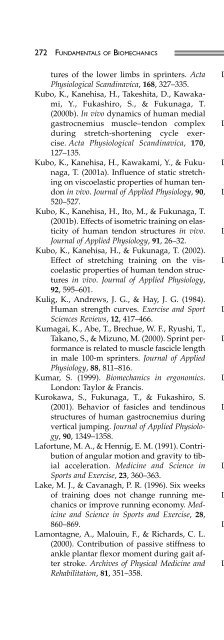Fundamentals of Biomechanics
Fundamentals of Biomechanics
Fundamentals of Biomechanics
You also want an ePaper? Increase the reach of your titles
YUMPU automatically turns print PDFs into web optimized ePapers that Google loves.
272 FUNDAMENTALS OF BIOMECHANICS<br />
tures <strong>of</strong> the lower limbs in sprinters. Acta<br />
Physiological Scandinavica, 168, 327–335.<br />
Kubo, K., Kanehisa, H., Takeshita, D., Kawakami,<br />
Y., Fukashiro, S., & Fukunaga, T.<br />
(2000b). In vivo dynamics <strong>of</strong> human medial<br />
gastrocnemius muscle–tendon complex<br />
during stretch-shortening cycle exercise.<br />
Acta Physiological Scandinavica, 170,<br />
127–135.<br />
Kubo, K., Kanehisa, H., Kawakami, Y., & Fukunaga,<br />
T. (2001a). Influence <strong>of</strong> static stretching<br />
on viscoelastic properties <strong>of</strong> human tendon<br />
in vivo. Journal <strong>of</strong> Applied Physiology, 90,<br />
520–527.<br />
Kubo, K., Kanehisa, H., Ito, M., & Fukunaga, T.<br />
(2001b). Effects <strong>of</strong> isometric training on elasticity<br />
<strong>of</strong> human tendon structures in vivo.<br />
Journal <strong>of</strong> Applied Physiology, 91, 26–32.<br />
Kubo, K., Kanehisa, H., & Fukunaga, T. (2002).<br />
Effect <strong>of</strong> stretching training on the viscoelastic<br />
properties <strong>of</strong> human tendon structures<br />
in vivo. Journal <strong>of</strong> Applied Physiology,<br />
92, 595–601.<br />
Kulig, K., Andrews, J. G., & Hay, J. G. (1984).<br />
Human strength curves. Exercise and Sport<br />
Sciences Reviews, 12, 417–466.<br />
Kumagai, K., Abe, T., Brechue, W. F., Ryushi, T.,<br />
Takano, S., & Mizuno, M. (2000). Sprint performance<br />
is related to muscle fascicle length<br />
in male 100-m sprinters. Journal <strong>of</strong> Applied<br />
Physiology, 88, 811–816.<br />
Kumar, S. (1999). <strong>Biomechanics</strong> in ergonomics.<br />
London: Taylor & Francis.<br />
Kurokawa, S., Fukunaga, T., & Fukashiro, S.<br />
(2001). Behavior <strong>of</strong> fasicles and tendinous<br />
structures <strong>of</strong> human gastrocnemius during<br />
vertical jumping. Journal <strong>of</strong> Applied Physiology,<br />
90, 1349–1358.<br />
Lafortune, M. A., & Hennig, E. M. (1991). Contribution<br />
<strong>of</strong> angular motion and gravity to tibial<br />
acceleration. Medicine and Science in<br />
Sports and Exercise, 23, 360–363.<br />
Lake, M. J., & Cavanagh, P. R. (1996). Six weeks<br />
<strong>of</strong> training does not change running mechanics<br />
or improve running economy. Medicine<br />
and Science in Sports and Exercise, 28,<br />
860–869.<br />
Lamontagne, A., Malouin, F., & Richards, C. L.<br />
(2000). Contribution <strong>of</strong> passive stiffness to<br />
ankle plantar flexor moment during gait after<br />
stroke. Archives <strong>of</strong> Physical Medicine and<br />
Rehabilitation, 81, 351–358.<br />
Laplaud, D., Hug, F., & Grelot, L. (2006). Reproducibility<br />
<strong>of</strong> eight lower limb muscles activity<br />
level in the course <strong>of</strong> an incremental<br />
pedaling exercise. Journal <strong>of</strong> Electromyography<br />
and Kinesiology, 16, 158–166.<br />
Larkins, C., & Snabb, T. E. (1999). Positive versus<br />
negative foot inclination for maximum<br />
height two–leg vertical jumps. Clinical <strong>Biomechanics</strong>,<br />
14, 321-328.<br />
Latash, M. L., & Zatsiorsky, V. M. (Eds.) (2001).<br />
Classics in movement science. Champaign, IL:<br />
Human Kinetics.<br />
Lawson, R. A., & McDermott, L. C. (1987). Student<br />
understanding <strong>of</strong> work–energy and<br />
impulse–momentum theorems. American<br />
Journal <strong>of</strong> Physics, 55, 811–817.<br />
Lees, A. (1999). Biomechanical assessment <strong>of</strong> individual<br />
sports for improved performance.<br />
Sports Medicine, 28, 299–305.<br />
Lees, A., & Barton, G. (1996). The interpretation<br />
<strong>of</strong> relative momentum data to assess the<br />
contribution <strong>of</strong> the free limbs to the generation<br />
<strong>of</strong> vertical velocity in sports activities.<br />
Journal <strong>of</strong> Sports Sciences, 14, 503–511.<br />
Lees, A., & Fahmi, E. (1994). Optimal drop<br />
heights for plyometric training. Ergonomics,<br />
37, 141–148.<br />
Lees, A., Vanrenterghem, J., & De Clercq, D.<br />
(2004). Understanding how an arm swing<br />
enhances performance in the vertical jump.<br />
Journal <strong>of</strong> <strong>Biomechanics</strong>, 37, 1929–1940.<br />
Legwold, G. (1984). Can biomechanics produce<br />
olympic medals? Physician and Sportsmedicine,<br />
12(1), 187–189.<br />
Lehman, G. J., & McGill, S. M. (2001). Quantification<br />
<strong>of</strong> the differences in electromyograpic<br />
activity magnitude between the upper<br />
and lower portions <strong>of</strong> the rectus abdominis<br />
muscle during selected trunk exercises.<br />
Physical Therapy, 81, 1096–1101.<br />
LeVeau, B. (1992). Williams and Lissner's: <strong>Biomechanics</strong><br />
<strong>of</strong> human motion (3rd ed.). Philadelphia:<br />
W. B. Sanders.<br />
Lieber, R. L., & Bodine-Fowler, S. C. (1993).<br />
Skeletal muscle mechanics: Implications for<br />
rehabilitation. Physical Therapy, 73, 844–856.<br />
Lieber, R. L., & Friden, J. (1993). Muscle damage<br />
is not a function <strong>of</strong> muscle force but active<br />
muscle strain. Journal <strong>of</strong> Applied Physiology,<br />
74, 520–526.<br />
Lieber, R. L., & Friden, J. (1999). Mechanisms <strong>of</strong><br />
muscle injury after eccentric contration.






